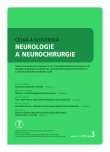Surgical Treatment Outcomes in Patients with „Pure“ Traumatic Epidural Hematoma
Authors:
R. Brabec; V. Beneš lll; P. Buchvald; P. Suchomel
Authors‘ workplace:
Neurochirurgické oddělení, Krajská nemocnice Liberec, a. s.
Published in:
Cesk Slov Neurol N 2015; 78/111(3): 323-327
Category:
Short Communication
Overview
Aim:
The aim of this study was to analyse surgical treatment outcomes in patients with pure epidural hematoma (EDH) treated during 5-year period at the Regional Hospital Liberec.
Patients and methods:
Retrospective analysis of patients with pure EDH treated between 2009 and 2013. We focused on trauma mechanism, alcohol intoxication, ipsilateral skull fracture, hematoma location, initial state of consciousness, time from injury to surgery and the effect of this timing on patient outcome as assessed by Glasgow Outcome Scale (GOS).
Results:
During the study period, 39 patients underwent craniotomy for EDH. Mean age was 38.3 (6–71) years, and 26 patients were men (67%). Most common trauma mechanism was fall (23 cases, 59%), alcohol intoxication was noted in 15 patients (38%). Ipsilateral skull fracture was present in 34 patients (87%). Mean time to diagnosis in patients transferred directly to our hospital was 290 minutes, mean time to surgery 419 minutes. Mean time to diagnosis in patients transferred via a peripheral hospital was 302 minutes, mean time to surgery in these patients was 538 minutes. There was no mortality, 30 patients (77%) achieved GOS 4 or 5, nine patients (23%) GOS 3. Patients’ initial clinical status proved to be significant for favourable GOS. There was no statistically significant difference in GOS between patients transferred directly and those via a peripheral hospital.
Conclusion:
EDH is a serious craniocerebral trauma and its outcome depends on initial clinical status and rapid diagnosis and treatment.
Key words:
epidural hematoma – craniocerebral trauma – prognosis – late diagnosis
The authors declare they have no potential conflicts of interest concerning drugs, products, or services used in the study.
The Editorial Board declares that the manuscript met the ICMJE “uniform requirements” for biomedical papers.
Sources
1. Bullock MR, Chesnut R, Ghajar J, Gordon D, Hartl R,Newell DW et al. Surgical management of acute subdural hematomas. Neurosurgery 2006; 58 (Suppl 3): S16 – S24.
2. Cheung PS, Lam JM, Yeung JH, Graham CA, Rainer TH. Outcome of traumatic extradural haematoma in Hong Kong Injury 2007; 38(1): 76 – 80.
3. Mraček Z, Škúci I. Epidurální hematom v zadní lebeční jámě. Zkušenosti s 18 zraněnými. Cesk Slov Neurol N 1999; 62/ 95(6): 336 – 339.
4. Paterniti S, Fiore P, Macri E, Marra G, Cambria M, Falcone F et al. Extradural haematoma. Report of 37 consecutive cases with survival. Acta Neurochir (Wien) 1994; 131(3 – 4): 207 – 210.
5. Suchomel P. Analysis of the causes of failure in the treatment of simple traumatic epidural hematomas. Rozhl Chir 1990; 69(10): 649 – 654.
6. Teasdale G, Jennett B. Assessment of coma and impaired consciousness. A practical scale. Lancet 1974; 2(7872): 81 – 84.
7. Jennett B, Bond M. Assessment of outcome after severe brain damage. Lancet 1975; 1(7905): 480 – 484.
8. Wester K. Decompressive surgery for „pure“ epidural hematomas: does neurosurgical expertise improve the outcome? Neurosurgery 1999; 44(3): 495 – 500.
9. Antoniadis G, Richter HP. Treatment measures in traumatic extracerebral hemorrhage. Management of epi - / subdural hemorrhage and prognosis. Unfallchirurg 1993; 96(11): 582 – 586.
10. Ortler M, Langmayr JJ, Stockinger A, Golser K, Russegger L, Resch H. Prognosis of epidural hematoma: is emergency burr hole trepanation in craniocerebral trauma still justified today? Unfallchirurg 1993; 96(12): 628 – 631.
11. Ruff LM, Mendelow AD, Lecky FE. Improving mortality after extradural haematoma in England and Wales. Br J Neurosurg 2013; 27(1): 19 – 23. doi: 10.3109/ 02688697.2012.709555.
12. Rehman L, Khattak A, Naseer A, Mushtaq. Outcome of acute traumatic extradural hematoma. J Coll Physicians Surg Pak 2008; 18(12): 759 – 762. doi: 12.2008/ JCPSP.759762.
13. Taussky P, Widmer HR, Takala J, Fandino J. Outcome after acute traumatic subdural and epidural haematoma in Switzerland: a single‑centre experience. Swiss Med Wkly 2008; 138(19 – 20): 281 – 285. doi: 2008/ 19/ smw ‑ 12056.
14. Wu JJ, Hsu CC, Liao SY, Wong YK. Surgical outcome of traumatic intracranial hematoma at a regional hospital in Taiwan. J Trauma 1999; 47(1): 39 – 43.
15. Kuday C, Uzan M, Hanci M. Statistical analysis of the factors affecting the outcome of extradural haematomas: 115 cases. Acta Neurochir (Wien) 1994; 131(3 – 4): 203 – 206.
16. Bulters D, Belli A. A prospective study of the time to evacuate acute subdural and extradural haematomas. Anaesthesia 2009; 64(3): 277 – 281. doi: 10.1111/ j.1365 ‑ 2044.2008.05779.x.
17. Deverill J, Aitken LM. Treatment of extradural hemorrhage in Queensland: interhospital transfer, preoperative delay and clinical outcome. Emerg Med Australas 2007; 19(4): 325 – 332.
18. Leach P, Childs C, Evans J, Johnston N, Protheroe R, King A. Transfer times for patients with extradural and subdural haematomas to neurosurgery in Greater Manchester. Br J Neurosurg 2007; 21(1): 11 – 15.
Labels
Paediatric neurology Neurosurgery NeurologyArticle was published in
Czech and Slovak Neurology and Neurosurgery

2015 Issue 3
Most read in this issue
- Addenbrooke’s Cognitive Examination – Approximate Normal Values for the Czech Population
- Spinal Shock – from Pathophysiology to Clinical Manifestation
- Diagnosis of Epileptic Seizures
- Verbal Fluency Tests – Czech Normative Study for Older Persons
